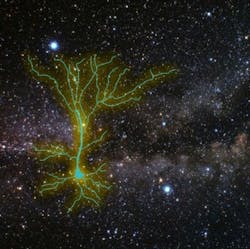Optogenetics finds what regulates synaptic activity in the neocortex
Using optogenetics, a team of scientists at Carnegie Mellon University (CMU; Pittsburgh, PA) has found that a specific type of neuron might be thwarting their efforts at mapping the connectome (a map of each and every connection between the millions of neurons in the brain) by temporarily cloaking the synapses that link a wide field of neurons.
Related: Optogenetics confirms that strengthened connections between neurons fuel memories
In a study, the scientists found that a class of inhibitory neurons, called somatostatin cells, send out a signal that silences neighboring excitatory neurons. Synapses can't be seen if they aren't firing; activating the somatostatin cells makes the synapses and local network of neurons invisible to researchers. Furthermore, by silencing certain parts of the neuronal network, the activity of the somatostatin neurons also can change the way the brain functions, heightening some perceptual pathways and silencing others.
"It was totally unexpected that these cells would work this way," says Alison Barth, professor of biological sciences and a member of BrainHub, CMU's neuroscience research initiative. "Changing the activity of just this one cell type can let you change the brain's circuit structure at will. This could dramatically change how we look at—and use—the connectome."
Joanna Urban-Ciecko, a research scientist in Barth's lab, noticed that the synapses in her experiments were not behaving the way that previous experimenters had reported. Prior studies reported that the synapses should be strong and reliable, and that they should always grow and strengthen in response to a stimulus. But the neurons Urban-Ciecko looked at were weak and unreliable.
The difference between Urban-Ciecko's research and the previously completed work was that her research was being done under real-life conditions. Prior research on synapse function was done under conditions optimized for observing synapses. However, such experimental conditions don't reflect the noisy brain environment in which synapses normally exist.
"There's this big black box in neuroscience. We know how to make synapses stronger in a dish. But what's going on in the brain to initiate synaptic strengthening in real life?" Barth asked.
To find out, Urban-Ciecko looked at neurons in the brain's neocortex that were functioning under normal, noisy conditions. She took paired-cell recordings from pyramidal cells, a type of excitatory neuron, and found that many of the synapses between the neurons were not functioning, or functioning at an unexpectedly low level. Urban-Ciecko then recorded the activity of somatostatin cells, a type of inhibitory neuron, and found that those neurons were much more active than expected.
"The somatostatin cells were so active, I wondered if they could possibly be driving the inhibition of synapses," Urban-Ciecko said.
To test her hypothesis, Urban-Ciecko turned to optogenetics, a technique that controls neurons with light. She used light to trigger an enzyme that activated and deactivated the somatostatin neuron. When the somatostatin cells were turned off, synapses grew big and strong. When the cells were turned on, the synapses became weaker and in some cases, disappeared entirely.
"You have inputs coming at you all the time, why do you remember one thing and not the other? We think that somatostatin neurons may be gating whether synapses are used, and whether they can be changed during some important event, to enable learning," says Barth, who is also a member of the joint CMU/University of Pittsburgh Center for the Neural Basis of Cognition (CNBC).
The researchers found that when the somatostatin neurons were turned on, this triggered the cloaking device. The neuron activated the GABAb receptors on hundreds of excitatory neurons in the immediate area. Activating this receptor suppressed the excitatory neurons, which prevented them from creating and strengthening synapses—and made them invisible to researchers.
The researchers next plan to see if the somatostatin cells behave similarly in other areas of the brain. If they do, it could represent a novel target for studying and improving learning and memory.
Full details of the work appear in the journal Current Biology; for more information, please visit http://dx.doi.org/10.1016/j.cub.2015.01.035.
-----
Follow us on Twitter, 'like' us on Facebook, connect with us on Google+, and join our group on LinkedIn

